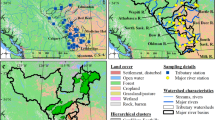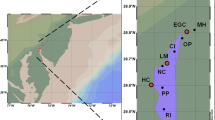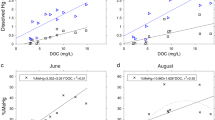Abstract
Spatial variation in mercury (Hg) and methylmercury (MeHg) bioaccumulation in urban coastal watersheds reflects complex interactions between Hg sources, land use, and environmental gradients. We examined MeHg concentrations in fauna from the Delaware River estuary, and related these measurements to environmental parameters and human impacts on the waterway. The sampling sites followed a north to south gradient of increasing salinity, decreasing urban influence, and increasing marsh cover. Although mean total Hg in surface sediments (top 4 cm) peaked in the urban estuarine turbidity maximum and generally decreased downstream, surface sediment MeHg concentrations showed no spatial patterns consistent with the examined environmental gradients, indicating urban influence on Hg loading to the sediment but not subsequent methylation. Surface water particulate MeHg concentration showed a positive correlation with marsh cover whereas dissolved MeHg concentrations were slightly elevated in the estuarine turbidity maximum region. Spatial patterns of MeHg bioaccumulation in resident fauna varied across taxa. Small fish showed increased MeHg concentrations in the more urban/industrial sites upstream, with concentrations generally decreasing farther downstream. Invertebrates either showed no clear spatial patterns in MeHg concentrations (blue crabs, fiddler crabs) or increasing concentrations further downstream (grass shrimp). Best-supported linear mixed models relating tissue concentration to environmental variables reflected these complex patterns, with species specific model results dominated by random site effects with a combination of particulate MeHg and landscape variables influencing bioaccumulation in some species. The data strengthen accumulating evidence that bioaccumulation in estuaries can be decoupled from sediment MeHg concentration, and that drivers of MeHg production and fate may vary within a small region.





Similar content being viewed by others
References
Ashley, J.T.F., M. Webster, R. Horwitz, D. Velinsky, and J. Baker. 2009. Polychlorinated biphenyls in sediment and biota from the Delaware River Estuary. Proceedings of the Academy of Natural Sciences of Philadelphis 158: 89–105.
ATSDR. 2013. Substance priority list. http://www.atsdr.cdc.gov/spl/. Accessed 14 Nov 2015.
Balcom, P., A. Schartup, R. Mason, and C.Y. Chen. 2015. Sources of water column methylmercury across multiple estuaries in the Northeast U.S. Marine Chemistry 177: 721–730.
Barton, K. 2015. MuMIn: multi-model inference. R Package version 1 (13): 4.
Bates, D., M. Maechler, B. Bolker, and S. Walker. 2014. Lme4: linear mixed-effects models using Eigen and S4. R package version 1: 1–7.
Bloom, N.S., and E.A. Crecelius. 1983. Determination of mercury in seawater at sub-nanogram per liter levels. Marine Chemistry 14: 49–59.
Bloom, N., and W.F. Fitzgerald. 1988. Determination of volatile mercury species at the picogram level by low-temperature gas chromatography with cold-vapour atomic fluorescence detection. Analytica Chimica Acta 208: 151–161.
Burns, D.A., M.R. McHale, C.T. Driscoll, and K.M. Roy. 2006. Response of surface water chemistry to reduced levels of acid precipitation: comparison of trends in two regions of New York, USA. Hydrological Processes 20: 1611–1627.
Chalmers, A.T., D.P. Krabbenhoft, P.C. Van Metre, and M.A. Nilles. 2014. Effects of urbanization on mercury deposition and New England. Environmental Pollution 192: 104–112.
Chen, C.Y., N. Serrell, D.C. Evers, B.J. Fleishman, K.F. Lambert, J. Weiss, R.P. Mason, and M.S. Bank. 2008. Meeting report: methylmercury in marine ecosystems-from sources to seafood consumers. Environmental Health Perspectives 116: 1706–1712.
Chen, C.Y., M. Dionne, B.M. Mayes, D.M. Ward, S. Sturup, and B.P. Jackson. 2009. Mercury bioavailability and bioaccumulation in estuarine food webs in the Gulf of Maine. Environmental Science & Technology 43: 1804–1810.
Chen, C.Y., M. Borsuk, D. Bugge, T. Hollweg, P. Balcom, D.M. Ward, J. Williams, and R. Mason. 2014. Benthic and pelagic pathways of methylmercury bioaccumulation in estuarine food webs of the northeast United States. PloS One 9: e89305.
Church, C.K., D. Sommerfield, D. Velinsky, C. Point, D. Benoit, D. Plaa Amouroux, and O. Donard. 2006. Marsh sediments as records of sedimentation, eutrophication and metal pollution in the urban Delaware Estuary. Marine Chemistry 102: 72–95.
Conaway, C.H., S. Squire, R.P. Mason, and A.R. Flegal. 2003. Mercury speciation in the San Francisco Bay estuary. Marine Chemistry 80: 199–225.
Cook, T.L., C.K. Sommerfield, and K.-C. Wong. 2007. Observations of tidal and springtime sediment transport in the upper Delaware Estuary. Estuarine Coastal and Shelf Science 72: 235–246.
DE Department of Natural Resources and Environmental Control. 2016. Delaware fish consumption advisories PDF. available at http://www.dnrec.delaware.gov/fw/Fisheries/pages/advisories.aspx. Accessed 16 Dec 2016.
Driscoll, C.T., C.Y. Chen, C.R. Hammerschmidt, R.P. Mason, C.C. Gilmour, E.M. Sunderland, B.K. Greenfield, K.L. Buckman, and C.H. Lamborg. 2012. Nutrient supply and mercury dynamics in marine ecosystems: a conceptual model. Environmental Research 119: 118–131.
Drott, A., L. Lambertsson, E. Bjorn, and U. Skyllberg. 2008. Do potential methylation rates reflect accumulated methyl mercury in contaminated sediments? Environmental Science & Technology 42: 153–158.
Dutton, J., and N.S. Fisher. 2011. Salinity effects on the bioavailability of aqueous metals for the estuarine killifish Fundulus heteroclitus. Environmental Toxicology and Chemistry 30: 2107–2114.
Eshleman, K.N., R.D. Sabo, and K.M. Kline. 2013. Surface water quality is improving due to declining atmospheric N deposition. Environmental Science & Technology 47: 12193–12200.
Evers, D.C., R.P. Mason, N.C. Kamman, C.Y. Chen, A.L. Bogomolni, D.L. Taylor, C.R. Hammerschmidt, S.H. Jones, N.M. Burgess, K. Munney, and K.C. Parsons. 2008. Integrated mercury monitoring program for temperate estuarine and marine ecosystems on the North American Atlantic coast. EcoHealth 5 (4): 426–441.
Fitzgerald, W.F., and G.A. Gill. 1979. Subnanogram determination of mercury by two-stage gold amalgamation and gas phase detection applied to atmospheric analysis. Analytical Chemistry 51: 1714–1720.
Fleeger, J.W., K.R. Carman, S. Webb, N. Hilbun, and M.C. Pace. 1999. Consumption of microalgae by the grass shrimp Palaemonetes pugio. Journal of Crustacean Biology 19: 324–336.
Fry, B., and M.M. Chumchal. 2012. Mercury bioaccumulation in estuarine food webs. Ecological Applications 22: 606–623.
Gosnell, K., P. Balcom, V. Ortiz, B. DiMento, A. Schartup, R. Greene, and R. Mason. 2015. Seasonal cycling and transport of mercury and methylmercury in the estuarine turbididty maximum of the Delaware Estuary. Aquatic Geochemistry. doi:10.1007/s10498-015-9283-x.
Gosnell, K., P.H. Balcom, C. Tobias, W. Gilhooly, and R.P. Mason. 2017. Spatial and temporal trophic transfer dynamics of mercury and methylmercury into zooplankton and phytoplankton of Long Island Sound. Limnology and Oceanography. doi:10.1002/lno.10490.
Greene, R. 2007. Mercury in Delaware surface water. Powerpoint presentation given at the 2007 Delaware Water Science Seminar, Dover.
Greene, R. 2011. An assessment of sediment metals data from the Delaware Estuary Benthic Inventory (DEBI). Powerpoint presentation given Feb 1: 2011.
Greene, R. 2013. Assessment of 2012 Delaware toxics in biota data. Dover: Delaware DNREC, Division of Watershed Stewardship.
Hammerschmidt, C.R., and W.F. Fitzgerald. 2001. Formation of artifact methylmercury during extraction from a sediment reference material. Analytical Chemistry 73: 5930–5936.
Hammerschmidt, C.R., W.F. Fitzgerald, C.H. Lamborg, P.H. Balcom, and P.T. Visscher. 2004. Biogeochemistry of methylmercury in sediments of Long Island Sound. Marine Chemistry 90: 31–52.
Hammerschmidt, C.R., W.F. Fitzgerald, P.H. Balcom, and P.T. Visscher. 2008. Organic matter and sulfide inhibit methylmercury production in sediments of New York/New Jersey Harbor. Marine Chemistry 109: 165–182.
Hollweg, T.A., C.C. Gilmour, and R.P. Mason. 2009. Methylmercury production in sediments of Chesapeake Bay and the mid-Atlantic continental margin. Marine Chemistry 114: 86–101.
Homer, C., J. Dewitz, L.M. Yang, S. Jin, P. Danielson, G. Xian, J. Coulston, N. Herold, J. Wickham, and K. Megown. 2015. Completion of the 2011 National Land Cover Database for the Conterminous United States—representing a decade of land cover change information. Photogrammetric Engineering and Remote Sensing 81: 345–354.
Hurlbert, S.H. 1984. Pseudoreplication and the design of ecological field experiments. Ecological Monographs 54: 197–211.
Hurley, J.P., J.M. Benoit, C.L. Babiarz, M.M. Shafer, A.W. Andren, J.R. Sullivan, R. Hammond, and D.A. Webb. 1995. Influences of watershed characteristics on mercury levels in Wisconsin rivers. Environmental Science & Technology 29 (7): 1867–1875.
Kneib, R. 1985. Predation and disturbance by grass shrimp, Palaemonetes pugio Holthuis, in soft-substratum benthic invertebrate assemblages. Journal of Experimental Marine Biology and Ecology 93: 91–102.
Lambertsson, L., and M. Nilsson. 2006. Organic material: the primary control on mercury methylation and ambient methyl mercury concentrations in estuarine sediments. Environmental Science & Technology 40: 1822–1829.
Lawson, N.M., R.P. Mason, and J.M. Laporte. 2001. The fate and transport of mercury, methylmercury, and other trace metals in Chesapeake Bay tributaries. Water Research 35 (2): 501–515.
Luengen, A.C., N.S. Fisher, and B.A. Bergamaschi. 2012. Dissolved organic matter reduces algal accumulation of methylmercury. Environmental Toxicology and Chemistry 31: 1712–1719.
Mason, R.P., and A.L. Lawrence. 1999. Concentration, distribution, and bioavailability of mercury and methylmercury in sediments of Baltimore Harbor and Chesapeake Bay, Maryland, USA. Environmental Toxicology and Chemistry 18: 2438–2447.
Mason, R.P., J.R. Reinfelder, and F.M. Morel. 1996. Uptake, toxicity, and trophic transfer of mercury in a coastal diatom. Environmental Science & Technology 30: 1835–1845.
Mason, R., P. Balcom, K. Gosnell, V. Ortiz, B. Dimento, and A. Schartup. 2014. Final report: sources and biogeochemical cycling of methylmercury and mercury in the sub-tidal reaches of the Delaware River Estuary.
Mazerolle, M.J. 2014. AICcmodavg: model selection and mulitmodel inference based on (Q)AIC(c). R package version 2: 0–1.
McMahon, K.W., B.J. Johnson, and W.G. Ambrose. 2005. Diet and movement of the killifish, Fundulus heteroclitus, in a Maine salt marsh assessed using gut contents and stable isotope analyses. Estuaries 28: 966–973.
Morgan, M.D. 1980. Grazing and predation of the grass shrimp Palaemonetes pugio. Limnology and Oceanography 25: 896–902.
Nakagawa, S., and H. Schielzeth. 2013. A general and simple method for obtaining R2 from generalized linear mixed-effects models. Methods in Ecology and Evolution 4.
NJ Department of Environmental Protection. 2016. Fish smart, eat smart: a guide to health advisories for eating fish and crabs caught in New Jersey waters. PDF available at http://www.state.nj.us/dep/dsr/njmainfish.htm. Accessed 16 Dec 2016.
Ortiz, V.L., R.P. Mason, and J.E. Ward. 2015. An examination of the factors influencing mercury and methylmercury particulate distributions, methylation and demethylation rates in laboratory-generated marine snow. Marine Chemistry 177: 753–762.
Pinedo, S., E. Jordana, M. Monia Flagella, and E. Ballesteros. 2014. Relationships between heavy metals contamination in shallow marine sediments with industrial and urban development in Catalonia (Northwestern Mediterranean Sea). Water Air and Soil Pollution 225.
Pinherio, J.C., and D.M. Bates. 2000. Mixed-effects models in S and S-Plus. New York: Springer.
R Core Team. 2015. R: a language and environment for statistical computing. Version 3.1.3. Vienna: Foundation for Statistical Computing.
Reinfelder, J., and L. Totten. 2006. Mercury in the Delaware River Estuary: Past and present. Report to the Delaware River Basin Commission.
Rodriguez, W., P.V. August, Y. Wang, J.F. Paul, A. Gold, and N. Rubinstein. 2007. Empirical relationships between land use/cover and estuarine condition in the Northeastern United States. Landscape Ecology 22: 403–417.
Sanudo-Wilhelmy, S.A., and G.A. Gill. 1999. Impact of the clean water act on the levels of toxic metals in urban estuaries: the Hudson River estuary revisited. Environmental Science & Technology 33: 3477–3481.
Schartup, A.T., R.P. Mason, P.H. Balcom, T.A. Hollweg, and C.Y. Chen. 2013. Methylmercury production in estuarine sediments: role of organic matter. Environmental Science & Technology 47: 695–700.
Schartup, A.T., P.H. Balcom, A.L. Soerensen, K.J. Gosnell, R.S.D. Calder, R.P. Mason, and E.M. Sunderland. 2015a. Freshwater discharges drive high levels of methylmercury in Arctic marine biota. Proceedings of the National Academy of Sciences of the United States of America 112: 11789–11794.
Schartup, A.T., U. Ndu, P.H. Balcom, R.P. Mason, and E.M. Sunderland. 2015b. Contrasting effects of marine and terrestrially derived dissolved organic matter on mercury speciation and bioavailability in seawater. Environmental Science & Technology 49: 5965–5972.
Skjelkvale, B.L., J.L. Stoddard, D.S. Jeffries, K. Torseth, T. Hogasen, J. Bowman, J. Mannio, D.T. Monteith, R. Mosello, M. Rogora, D. Rzychon, J. Vesely, J. Wieting, A. Wilander, and A. Worsztynowicz. 2005. Regional scale evidence for improvements in surface water chemistry 1990-2001. Environmental Pollution 137: 165–176.
Sommerfield, C.K., and K.-C. Wong. 2011. Mechanisms of sediment flux and turbidity maintenance in the Delaware Estuary. Journal of Geophysical Research-Oceans 116.
Sunderland, E.M. 2007. Mercury exposure from domestic and imported estuarine and marine fish in the US seafood market. Environmental Health Perspectives 115: 235–242.
Sunderland, E.M., A. Amirbahman, N.M. Burgess, J. Dalziel, G. Harding, S.H. Jones, E. Kamai, M.R. Karagas, X. Shi, and C.Y. Chen. 2012. Mercury sources and fate in the Gulf of Maine. Environmental Research 119: 27–41.
Taylor, V.F., B.P. Jackson, and C.Y. Chen. 2008. Mercury speciation and total trace element determination of low-biomass biological samples. Analytical and Bioanalytical Chemistry 392: 1283–1290.
Taylor, V.F., A. Carter, C. Davies, and B.P. Jackson. 2011. Trace-level automated mercury speciation analysis. Analytical Methods 3: 1143–1148.
Tseng, C.-M., C.R. Hammerschmidt, and W.F. Fitzgerald. 2004. Determination of methylmercury in environmental matrixes by on-line flow injection and atomic fluorescence spectrometry. Analytical Chemistry 76: 7131–7136.
U.S. Environmental Protection Agency. 1998. Method 7473: mercury in solids and solutions by thermal decomposition, amalgamation, and atomic absorption spectrophotometry. Washington, D.C.
U.S. Environmental Protection Agency. 2013. 2011 National Listing of Fish Advisories. EPA-820-F-13-058.
United Nations Environmental Programme. 2013. Global Mercury Assessment 2013: sources, emissions, releases and environmental transport. UNEP Chemicals Branch, Geneva, Switzerland. 44pp.
Van Metre, P.C. 2012. Increased atmospheric deposition of mercury in reference lakes near major urban areas. Environmental Pollution 162: 209–215.
Zuur, A., E. Ieno, N. Walker, A. Saveliev, and G. Smith. 2009. Mixed effects models and extensions in ecology with R. New York: Springer.
Acknowledgements
We wish to thank A. Schartup for assistance with field collections and C. McCleery, V. Ortiz, and N. Mazrui for assistance with sample processing. R. Greene provided valuable suggestions to improve the manuscript, as did three anonymous reviewers. We acknowledge help from the Delaware Department of Natural Resources and Environmental Control (DNREC). This work was funded by grants from The USDA Forest Service (Nislow, 09-JV-11242307-124), NIEHS (Chen, R01 ES021950), and NIH/NIEHS (Stanton P42 ES007373).
Author information
Authors and Affiliations
Corresponding authors
Additional information
Communicated by Wen-Xiong Wang
Electronic supplementary material
ESM 1
(DOC 135 kb)
Rights and permissions
About this article
Cite this article
Buckman, K., Taylor, V., Broadley, H. et al. Methylmercury Bioaccumulation in an Urban Estuary: Delaware River, USA. Estuaries and Coasts 40, 1358–1370 (2017). https://doi.org/10.1007/s12237-017-0232-3
Received:
Revised:
Accepted:
Published:
Issue Date:
DOI: https://doi.org/10.1007/s12237-017-0232-3




